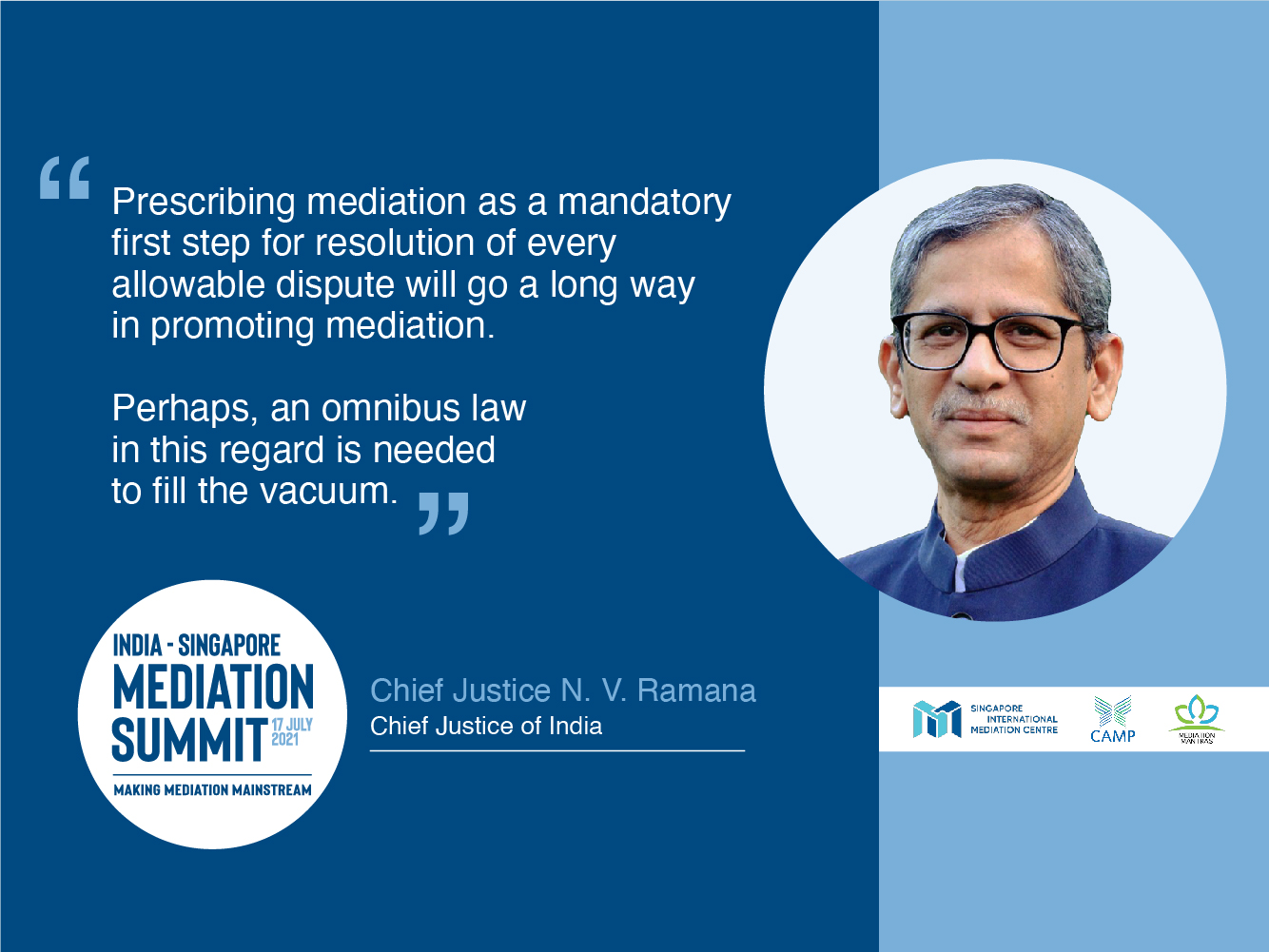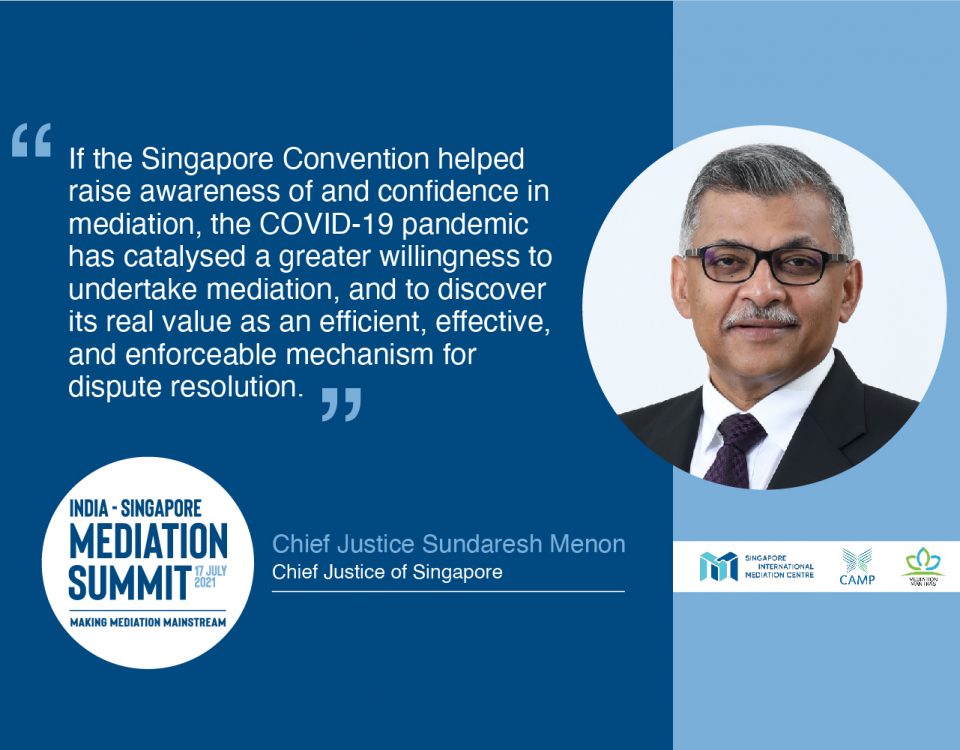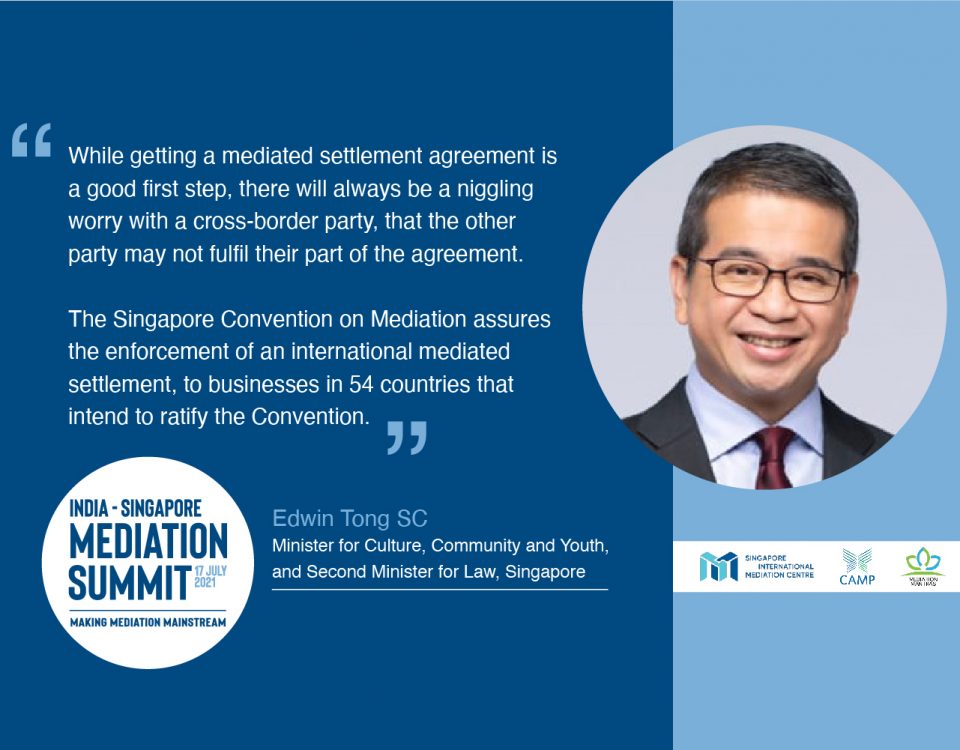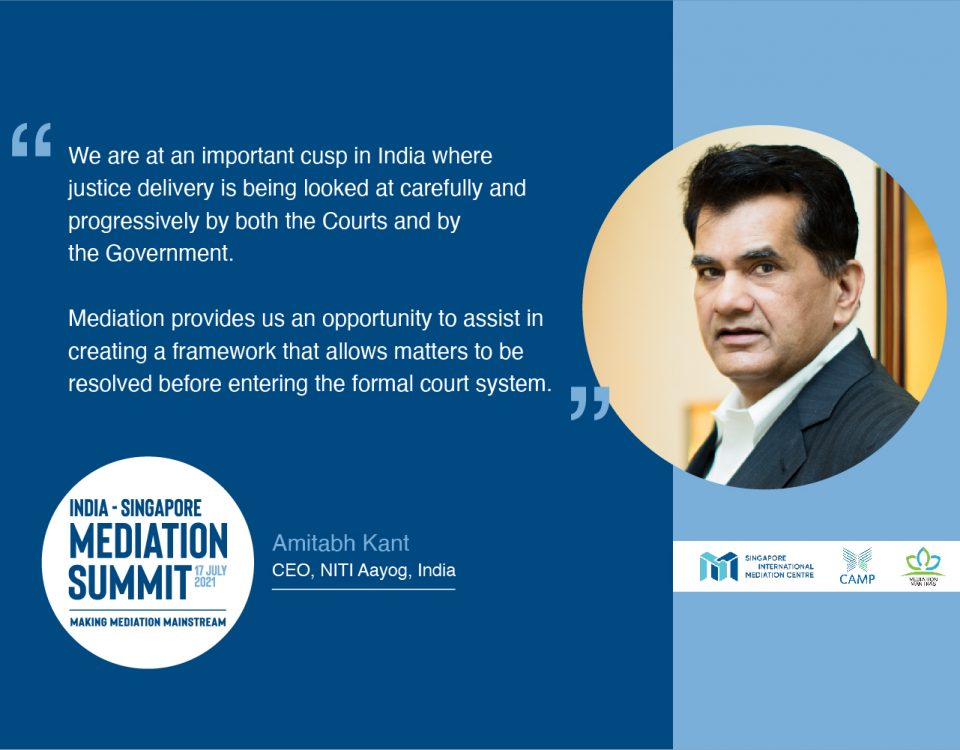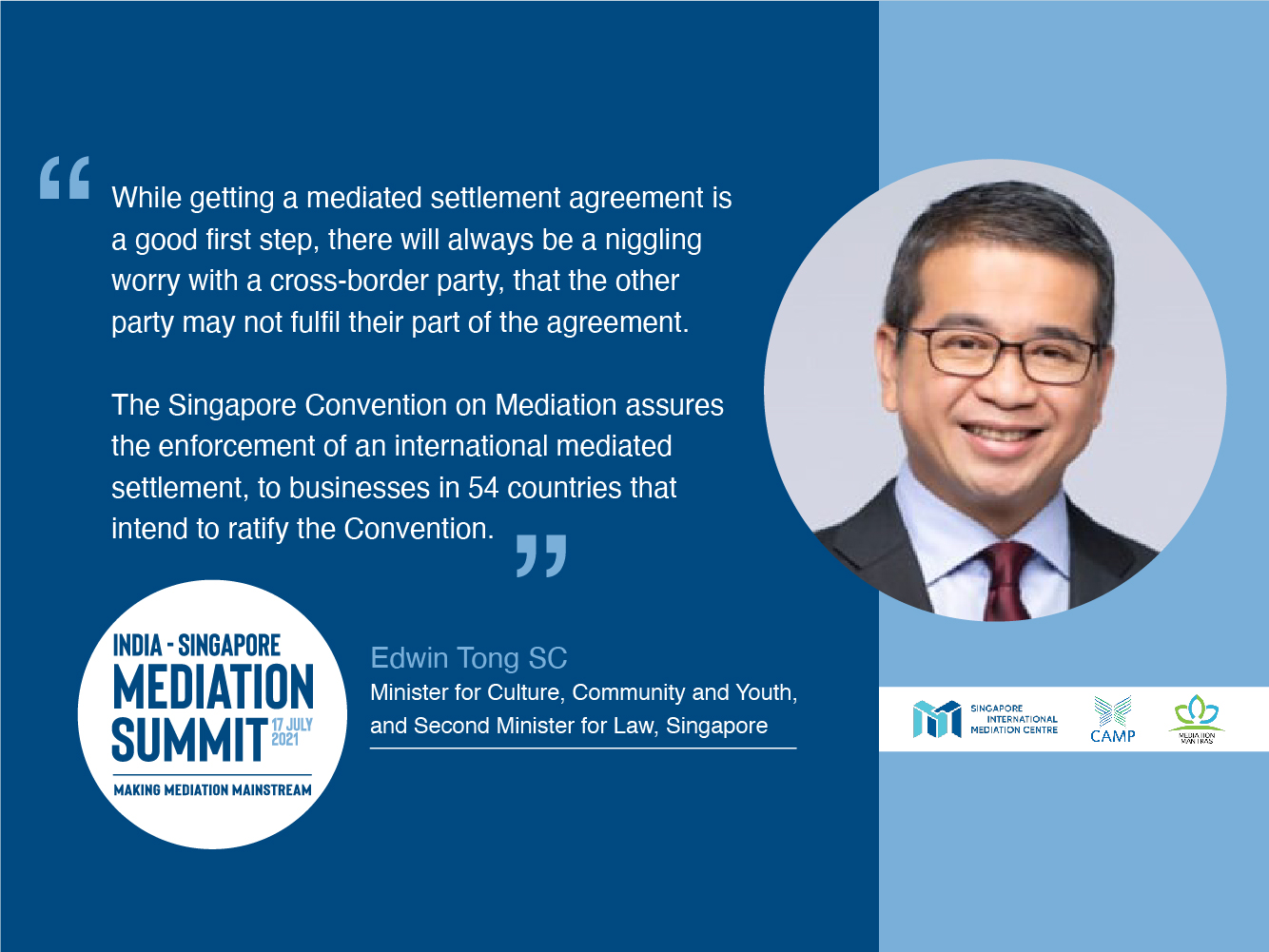
Address by Minister Edwin Tong SC at ISMS2021
17th July 2021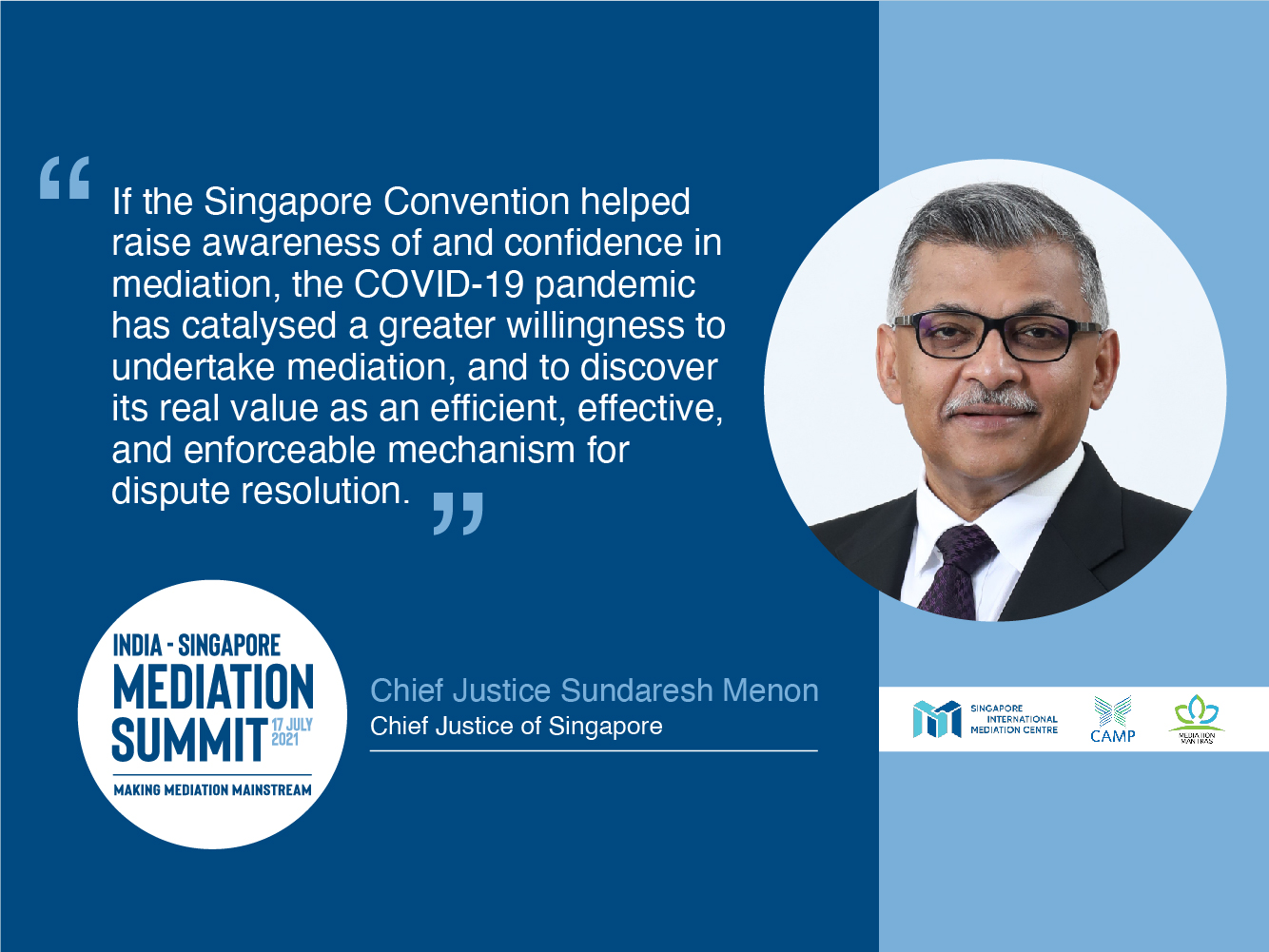
Keynote Address by CJ Sundaresh Menon at ISMS2021
17th July 2021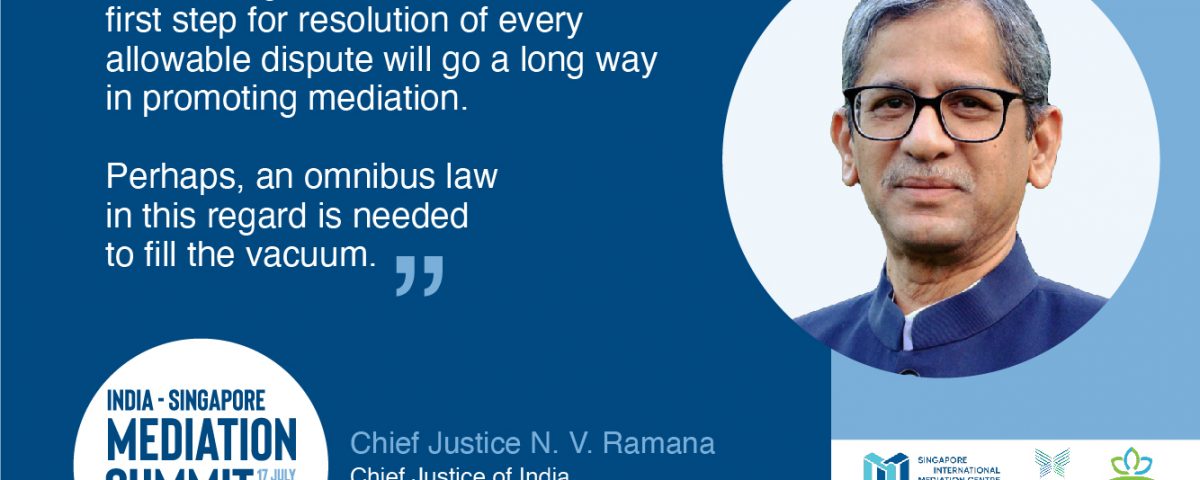
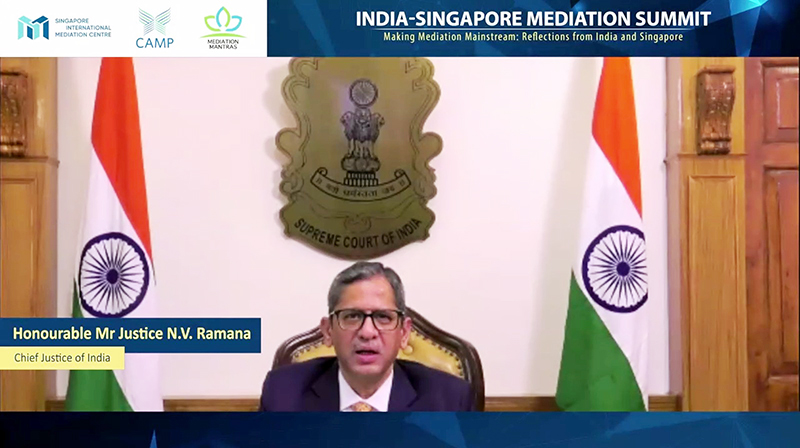
Chief Justice NV Ramana - Chief Justice of India, at the India - Singapore Mediation Summit 2021
Chief Justice N.V. Ramana
Mediation for Everyone: Realizing Mediation’s Potential in India
Keynote Address Delivered By
The Honourable Mr. Justice N. V. Ramana, the Chief Justice of India
Supreme Court of India
The Honourable Chief Justice of Singapore Mr. Sundaresh Menon
Mr. Edwin Tong, Minister for Culture, Community and Youth, and Second Minister for Law, Singapore
Mr. Justice A.K. Sikri, Former Judge, Supreme Court of India
Mr. Amitabh Kant, Chief Executive Officer, NITI Aayog
Mr. George Lim, Chairman of the Singapore International Mediation Centre
Honourable Judges (sitting and retired) from India, Singapore, and other countries
Distinguished Members of the Bar from across the world
Media persons
Distinguished Guests
Ladies and Gentlemen
Namaskar
Let me start by expressing my gratitude to everyone involved in organizing today’s event. A seemingly impossible task has been made possible through everyone’s hard work and support. To this end, let me appreciate and congratulate everyone at the Singapore International Mediation Centre, CAMP, Mediation Mantras, and the officers of the Supreme Court of Singapore and the Supreme Court of India.
I am extremely pleased to share this platform with Honourable Mr. Justice Sundaresh Menon, the very eminent Chief Justice of Singapore. His kindness and generosity of spirit were apparent during my earlier interaction with him.
I would also like to thank my dear brother, Justice Sikri, who has been a constant source of support and help throughout this process. His guidance throughout my time in the Supreme Court has been invaluable.
I am delighted to be speaking at this event, as over the past eighteen months we have not been able to interact due to the pandemic. Meeting all of you, even online, gives me immense pleasure.
Conflicts are unavoidable in any society for a variety of reasons-political, economic, social, cultural and religious. And with conflicts, there is also the need to develop mechanisms for conflict resolution. India, and numerous Asian countries, have a long and rich tradition of collaborative and amicable settlement of disputes.
The great Indian epic, the Mahabharata, actually provides an example of an early attempt at mediation as a conflict resolution tool, where Lord Krishna attempted to mediate the dispute between the Pandavas and Kauravas. It may be worthwhile to recall that the failure of mediation led to disastrous consequences.
Mediation, as a concept, is deeply embedded into the Indian ethos.
Long before the arrival of the British adversarial system in India, various forms of mediation were being practiced as a method of dispute resolution. Disputes were often resolved by the chieftains or elders of the community. Similarly, disputes relating to business were resolved by merchants, either by direct negotiations or through merchant bodies. However, the establishment of the British courts system, in 1775, marked the erosion of community-based indigenous dispute resolution mechanisms in India.
The British judicial system has ultimately become the framework, with appropriate modifications, for the current judicial system in India. A funny anecdote captures the attitude of Judges in this adversarial system: when a judge was sipping his early morning coffee, flipping through the newspaper, his granddaughter approached him and said, “Grandpa, my older sister has taken away my toy”. The judge’s immediate response - “Do you have any evidence?”
The Indian judicial system is unique not only because of a written Constitution, but also because of the immense faith reposed by the people in the system. People are confident that they will get relief and justice from the judiciary. It gives them the strength to pursue a dispute. They know that when things go wrong, the judiciary will stand by them.
The Indian Supreme Court is the guardian of the largest democracy. The Constitution gives wide ranging powers and jurisdiction to do complete justice between the parties to bring to life the motto of the Indian Supreme Court, “Yato Dharma Sthato Jaya”, that is, “Where there is Dharma, there is Victory”.
Having said that, I think there are a few contributing factors that have revived the Alternate Dispute Resolution (ADR) mechanisms in India.
The first one relates to judicial delays. The often-quoted statistic that “pendency” in Indian Courts has reached 45 million cases, which is perceived as the inability of the Indian judiciary to cope with the caseload. This is an overstatement and an uncharitable analysis.
The term pendency is used to refer to all cases which have not yet been disposed of, without any reference to how long the case has spent in the judicial system. This would mean, that a case which was filed yesterday gets added to the pendency statistic. This is, therefore, not a useful indicator of how well, or poorly, a system is doing.
Rather, it is important to reduce “arrears” and “backlogs” in the system. “Arrears” refer to delays that are unwarranted. Every delay is not an arrear. Some cases of delay might be due to valid reasons. On the other hand, “backlogs” refers to a situation where the number of cases instituted in a period is more than the number of cases disposed of in the same period.
There is no doubt that the issue of judicial delays is a complex problem, not just in India. Several factors contribute towards such a situation. One of them is an Indian phenomenon called - ‘luxurious litigation’.
It is a specific type of litigation wherein parties with resources attempt to frustrate the judicial process and delay it by filing numerous proceedings across the judicial system. Undeniably, the prevailing pandemic has also contributed to our woes.
The sheer number of cases in the Indian judicial system may have to be viewed in the context that India is the largest democratic republic in the world. The people believe in the Constitutional project, of which the judiciary is an integral part. Judges in India, particularly in the Constitutional Courts, often burn the midnight oil to meet their judicial and administrative case load.
The second factor which contributed to the growth of ADR, relates to the increased access to justice in India. It can safely be stated that the legal aid programme in India is one of the largest and most robust. Under the Legal Services Authorities Act, 1987 the judiciary has been given statutory backing and responsibility in ensuring greater access to justice, and I can proudly state that it is one of the greatest success stories of modern India.
Nearly 70% of the Indian population, particularly the poor, women, children, minorities, senior citizens and the differently abled, are eligible for benefits under various schemes run by Legal Service Authorities. As we enter the silver jubilee year of the establishment of the National Legal Services Authority, it is time to rejoice in the remarkable achievements and to further strengthen the legal aid movement in the country.
Apart from increasing legal awareness, the National Legal Services authority encourages the settlement of disputes through ADR. One such mechanism is the Lok Adalat (literally, People’s Court). Lok Adalats are tasked with the responsibility of settling cases which are referred to them from Courts, or by parties themselves, prior to initiating litigation. To give you some indication of the scope of the activities, over 7.84 million cases were settled by the Lok Adalats in 2019 and 2020. Nearly 3.94 million cases were settled at the pre-litigation stage. This is despite the pandemic and was possible by building an efficient Online Dispute Resolution system in India.
Another important factor that resulted in India’s shift towards ADR mechanisms, relates to the opening of the Indian market- that is, the major economic reforms undertaken in 1995. Laws were required to be modified to keep pace with ever changing society and its needs. There was a need to increase the confidence of investors and businesses, both domestic and foreign, and allow them more autonomy and control in resolving the disputes arising out of their investments and business plans.
After India opened its economy, the Parliament enacted the Arbitration and Conciliation Act, 1996 to bring the Indian arbitration regime in line with the UNCITRAL Model Law. This was probably the most important legal reform, which has received immense attention by the Indian legal and business community. The law attempts to put a framework in place that allows for maximum party autonomy, with the least judicial interference.
ADR mechanisms, particularly mediation and conciliation, can reduce pendency, save resources and time, and allow litigants a degree of control over the process and outcome of their dispute resolution process.
Designed around a participatory model, mediation and conciliation enable parties to become insiders to a process that traditionally treated them as outsiders.
As a result, the focus has shifted to the flexible non-adjudicatory dispute resolution processes of Mediation and Conciliation. ‘Mediation’ and ‘Conciliation’ are interchangeable expressions in many jurisdictions. However, in India, the Conciliator has wider powers than a Mediator. The Conciliator can make a proposal for settlement and can formulate the terms of the settlement. The mediator, on the other hand, only acts as a facilitator for the parties to come to a settlement.
Unlike Conciliation, which is governed by the Arbitration and Conciliation Act, 1996, mediation is not governed by any specific statute in India. The Industrial Disputes Act, 1947 had a provision regarding mediation. More recently the Commercial Courts Act, 2015 and the Real Estate (Regulation and Development) Act, 2016 have provisions relating to compulsory pre-litigation mediation. Amendments have also been made to the Companies Act, 2013 and the Consumer Protection Act, 2019 that allow for mediation. Most importantly, a provision in India’s Civil Procedure Code (CPC) empowering Courts to refer parties to mediation was revived by the Parliament in 1999, being Section 89 CPC. However, it was left to the Indian Supreme Court to give life to this Section of the Code.
The absence of any guidelines or rules for the operation of mediation was being sorely felt and was one of the reasons that mediation was not taken up. In a constitutional challenge to Section 89 CPC, the Supreme Court of India appointed a Committee to draft Mediation Rules, which were subsequently approved. All the High Courts were directed to frame the rules. This led to the development of Court-Annexed Mediation in India.
In the celebrated judgment of Afcons International, the Supreme Court of India clarified certain ambiguities which were inherent in the drafting of Section 89 CPC. The section, as it originally stood, placed the cart before the horse. The Supreme Court held that it is the duty of the Court to find out the suitability of ADR resolution of a particular dispute and refer the parties for the same. Further, the Court facilitated the enforceability of such settlements, by requiring them to be made a part of the final decree.
Court annexed mediation, along with the mandate to refer matters to ADR mechanisms under Section 89 CPC can be considered an Indian adaptation of the “Multi-Door Court House” proposed by the Harvard Professor, Frank Sander.
The model suggested by Professor Sander, included a Centre that would contain numerous dispute resolution mechanisms under one roof. A screening would take place and after a determination of the nature of the problem, the parties would be referred to the appropriate “door” to resolve their disputes.
In the current Indian scenario, the “screening” provided for under Section 89 CPC takes place within the Court. Subsequently, the Court may refer the matter to the appropriate ADR mechanism, including mediation. Such mediation referrals often happen even in the Supreme Court of India, and I have personally seen disputes that have subsisted for decades get resolved through the process of mediation, within a short time.
The Afcons International judgment also highlighted certain types of disputes that it would be profitable for a Court to refer to mediation, and certain other categories of cases wherein mediation might not be appropriate. It may merit mentioning that most cases being referred to court-annexed mediation relate to family or matrimonial disputes.
Private mediations, which take place at the pre-litigation stage, are also becoming more prevalent in the country. Most arbitration clauses in commercial contracts have a multi-tiered approach, where the first attempt to resolve the dispute between parties is through mediation or negotiation. At this juncture, it might be worth mentioning that the House of Lords held, in 1992, that agreements to have “good faith discussion” before opting for arbitration or Court litigation were not binding. On the other hand, India and Singapore are among the few jurisdictions to have taken a different path and made such agreements enforceable.
Apart from enhancing and clarifying the law as to mediation, the Supreme Court of India also made an active effort on the administrative side to improve the mediation landscape in India. The Supreme Court Mediation and Conciliation Project Committee was set up in 2005 by the then Chief Justice of India. Some of the Committee’s most important activities relate to the training of Mediators and Referral Judges throughout the country, along with publication of Training Manuals.
A development in 2019, which bears special mention relates to the Singapore Convention on Mediation. This is intended to create a framework for cross-border enforcement of international settlement agreements marked a huge step forward. The Convention is important for creating trust and faith with respect to international commercial settlement agreements. India was one of the first signatories of the Singapore Convention in 2019.
This brings me to the current state of mediation in India. There are nearly 43,000 mediation centres in India. The data suggests that since 2005, nearly 3.22 million cases have been referred and nearly 1 million cases have been settled by mediation upto March 2021.
Despite the encouraging figures, certain barriers persist with respect to the adoption of mediation in India. Before ensuring the success of Mediation in the country, it is necessary to address issues of legitimacy, credibility, and acceptability of mediation. I would like to leave you with some concluding thoughts regarding modern mediation practice that I believe merit highlighting and deserve discussion.
The first relates to the role of a Mediator in the dispute resolution process. Traditionally, mediation was thought of as a facilitative process. The Mediator played the passive, and limited, role of improving communication between parties. He only needed to ensure that parties understood the underlying issues and enabled them to reach a beneficial resolution to their dispute. They therefore acted only as a guide, leading the parties to the best solution. However, with more complex and sophisticated problems now being referred to mediation, particularly in the commercial arena, the role of Mediators is changing to include both evaluative and advisory participation.
The Mediator is now being asked to provide more active assistance to the parties to reach a settlement. He is expected to assess the relative strengths and weaknesses of each party, and suggest solutions based on the same. When the role becomes advisory, there is an inherent risk of the Mediator losing neutrality, opening up the door for temptations and extraneous considerations.
The second issue relates to the extent of ‘neutrality’ and ‘aloofness’ a mediator must possess during the process. You can call these problems the mediator’s ‘moral dilemma’.
The theory of mediation contemplates two parties who are equal in bargaining capacity seeking the assistance of the mediator to resolve their disputes. But what happens when one party is better situated- economically, socially and politically, than the other? What is the duty of a mediator if the settlement reached is patently unjust to the weaker party? Should the mediator be a silent spectator during such negotiations? Is the mediator merely concerned with enabling the parties to arrive at a settlement and not concerned with the terms of the settlement?
These are just some of the questions which one must consider, particularly in a country like India with our diverse social fabric. The requirements of substantive equality are a bedrock of every Constitutional democracy, and these ideals must be reflected even during the dispute resolution process.
Let me clarify that my intention in flagging these concerns is not to discourage mediation, but to make it a more robust process. My object is to initiate a debate and discussion in regard to the nature and limits of the role of a Mediator, so that it can be clearly and carefully calibrated. Rather, the mediator must be equipped to understand the situation of the parties before him, and to choose the appropriate approach. This can only be made possible with carefully designed, in-depth and continuous training of Mediators. I believe that it may be beneficial to take a leaf out of the book of the aviation industry. Commercial pilots are mandated to train every year. Such training usually contains a ‘simulator’ component, wherein pilots are given multiple scenarios through which they must safely land the plane in a flight simulator software. Mediators’ training programmes should contain such a component, and the development of a game-like software for Mediators might be a useful innovation to have in place.
This also brings me to another important factor - the need for ethical standards and unimpeachable integrity and neutrality of mediators.
As I mentioned earlier, a more active involvement of the mediator in the process of mediation could open the doors to parties attempting to influence them. This necessitates the creation of an environment which prevents any such attempts being made by an unscrupulous party. It requires that mediators be of good character and moral standing. For this, it is necessary, that Rules and Regulations governing Mediators are updated and implemented to ensure transparency and neutrality.
The points that I have highlighted are only illustrative, and any solutions suggested are rudimentary at best. I am hopeful that the present Summit will foster a dialogue from which solutions may emerge. I am looking forward to the conclusions that emerge from the interactions between practitioners in Singapore and India.
Given the growing scope of mediation, it is time for India to enter mission mode. To popularise mediation as cheaper and faster dispute resolution mechanism, a movement needs to be launched.
Prescribing mediation as a mandatory first step for resolution of every allowable dispute will go a long way in promoting mediation. Perhaps, an omnibus law in this regard is needed to fill the vacuum.
We must take note of the fact that a vast majority of litigants in India belong to middle and poorer sections of society. They will find great solace if mediation gets established as a reliable means of redress.
Needless to state, it will lead to a remarkable reduction in the number of cases reaching the regular courts. Such a scenario will enhance the efficiency of the judicial system.
India, the world’s largest democracy, is home to many identities, religions and cultures which contribute to its unity through diversity. This is where the rule of law, with assured sense of justice and fairness come into play.
Mediation, being the cheapest and simplest option available to the public at large, can be described as a tool of social justice in the Indian context. Such a party friendly mechanism ultimately upholds the rule of law, by providing an incentive for parties to utilize their autonomy to the fullest to arrive at a just and equitable outcome.
Several States in India are currently coming to build a robust ADR-friendly environment. Recently, the State of Telangana has come forward to set up a state-of-the-art ADR facility. This is a welcome move and I hope other States will soon follow.
Cooperation between India and Singapore is going to be a significant factor in promoting alternate dispute redressal mechanisms in both our countries, as well as in the entire subcontinent.
I would like to conclude with the words of Abraham Lincoln:
“Discourage litigation. Persuade your neighbour to compromise whenever you can. As a peace-maker, the lawyer has a superior opportunity of being a good man. There will still be business enough.”
Thank You.
This Keynote Address, was delivered by the Honourable Chief Justice of India, Justice N.V. Ramana, on 17th July 2021, at the India - Singapore Mediation Summit (ISMS2021).
ISMS2021 was organised by Singapore International Mediation Centre (SIMC), in strategic partnership with CAMP Arbitration & Mediation Practice, and Mediation Mantras.



